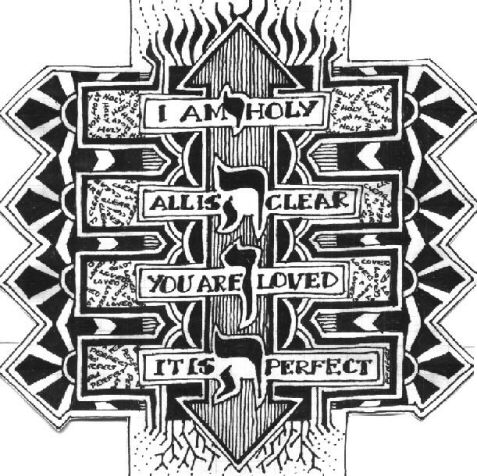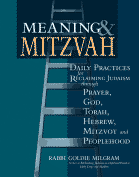Jewish meditation offers a way to infuse each of facet of Judaism with deeper meaning. Jewish meditation is not an end in itself, rather a partner process for healthy Jewish living. Reports of meditation experiences are widely found in Jewish sacred texts. For example:
-Torah teaches that Isaac went out into a field to meditate and discovered his future life-partner upon looking up in that state of consciousness. [Genesis, Bereshit 24:63]
-Regarding the prophets Maimonides' grandson, Abraham Maimonides (1186-1237) wrote: "The biblical prophets did not prophesy at will. Rather they focused their minds and sat joyfully and contentedly in a state of meditation." [Mishneh Torah, Yesodai ha-Torah 7:4]
-In the Talmud our sages are described as meditating for an hour before and after services.
-Contemplative movement are also depicted in the Talmud, Rabbi Akiva is described in the Talmud, Berachot 31a, as bowing and prostrating himself to the point he moved from one corner of the room to the other while praying at home. And there is also the Talmudic recommendation that when bowing in prayer "like a snake" one should "hyper-extend the spine until one can read the words on a coin set in front of your feet on the ground."
Much of the research undertaken by the original Kabbalists involves meditation-based practices which are then shared, reviewed and fine-tuned with colleagues and students.
What is the purpose of Jewish meditation?
Just as healthy foods nourish us through the blood stream, so Jewish meditation nourishes our "soul stream." Meditation can transform Judaism from the purely intellectual process most of us grew up with into a spiritual practice that links us to Judaism in the most profound way. Meditation helps us go under our intellectual defenses making it possible to experience the healing and ethical alignment that arises out of feeling at one with creation. Each mitzvah, holy day and cycle of life has its own rhythm, nuance, taste and character. Jewish meditation can also help us shift into these facets of Judaism, deepening our connection to them.
Should meditation be done in a group or alone?
Both. Recent bio-medical studies indicate that group meditation enhances the benefits of solitary meditation. When a minyan (10) of Jews meditates together, there is a reciprocity of awareness, caring, and support that emerges so long as there is careful attention to the dynamics of interpersonal power and the intention to support one another through your silence, sound, and focus. The ancient innovators and even some today in the field of Jewish spirituality mysticism have had a tendency to think of themselves as a messiah, a distortion distinctly unhelpful to the formation of healthy communities. Meditating on your own has many advantages too. Solitary meditators can experience a wonderful closeness to G*d, the flow of what Kabbalists call "The River of Light" can add energy and delight to your day.
Are there different kinds of Jewish meditation?
Yes! An exciting variety of approaches exist. Depending upon your emotional make-up, the circumstances and the effect you desire to create, one might suit you better than another. But whatever technique you choose, the benefits of a regular program of Jewish meditation will intensify with daily practice and delicious nuances of experience and awareness will emerge over time.
How Do I Learn Jewish meditation?
Most types of Jewish meditation are simple to learn under the auspices of a good teacher. Some are more complex and require careful preparation and guidance. It is important to experiment and find the technique and teacher(s) that works best for you.
Major methods of Jewish meditation include:
1. Focusing upon a Shiviti - Here a story "The Instrument" and guide to meditating upon a special Jewish artwork style that includes the Tetragrammaton, which helps induct a mystical state of consciousness. Recommendation: The artwork of David Friedman, Jackie Olenick, Betsy Teutsch and many others, including the shiviti art of Morty Breier of Hawaii shown here: that uses the Kabbalistic Four Worlds correlation to each of the four letters as interpreted by Rabbi Dr. Zalman Schachter-Shalomi.

One can also meditate on permutations of the letters of the Tetragrammaton. Recommendations: Jewish Meditation by Aryeh Kaplan and also his Meditation and Kabbalah, who also teaches another form Ayin Meditation in these works. The medieval Jewish mystic The Ari suggested imaginally taking the vowels of the mitzvah Yirah (the Divine as Awesome and Fearsome) and placing them under the YHVH, the Tetragrammaton.
3. Walking, dancing & movement meditations. The Otiot Khayyot developed by Yehudit Goldfarb, as also taught in workshops under the titel Moving the Hebrew Letters by Marcella K. Levie, as well as her book by the same titlel. Also Torah Yoga, and movement-based meditation and healing work at the Institute for Jewish Spirituality. Recommendation: Retreats and materials by Latifa B. Kropf on her approach to Jewish sacred dance. Jewish Sufi-style Zikr chant with movement through a Jewish lens as in this video of Rabbi Pam Frydman; and also unique and deep healing and empowering movement meditation teacher and guides are Rabbi Diane Elliot and Myriam Klotz. And there are so many more.
3. Hitbodedut - hitbodedus, a process of "emptifying" in order to refill with vision and spirit, is sometimes considered to be a form of Ayin meditation and certainly of authentic prayer. The author of the devotional Shabbat poem Yedid Nefesh, Eleazar Azikri [1533-1600], described study as the practice for the intellect and quoted his teacher the Ari, as considering a Jewish meditation practice known as hitbodedut/hitbodedus (linked example experience) to be seven fold more helpful to the soul. Here is an article on hitbodedut "Jewish Vision Quest."
The entire profound method developed by Dr. Eugene Gendlin, known as Focusing (TM) is more a form of spiritual direction akin to hashmal, the "Speaking Silence" in Ezekial 1:4, where layers need to be released before core revelations can emerge. Here's the source text:
"And I looked, and, behold, a stormy wind came from the north, a great cloud, and a fire flaring up, and a brightness was around it, out of its midst, the speaking silence, out of the midst of the fire." -Ezekiel 1:4 [also see Kings I, 19:11-12]
The entry steps of Focusing, known as "clearing a space" are perfect for entry into hisbodedus as well as other forms of Ayin consciousness and prayer. Here is an introduction to Judaism and Focusing. Here is an example within Jewish Life Mentoring of Rabbi Dr. Goldie MIlgram, founder and director of Reclaiming Judaism leading a Focusing session.
2. Tefillin and even on its own the Prophet Hosea's verses for tefillin also prayed at some Jewish weddings are a tool for relational meditation. And here's a funny tefillin story (humor is also good for the spirit.)
2. Chanting of verses from psalms, Torah and prayers. Recommendation: Seeking & Soaring: Jewish Approaches to Spiritual Direction, see the chapter by Rabbi Shefa Gold and chants are often discussed in the many other chapters by contemporary Jewish spiritual masters. Shefa's Flavors of Gratefulness app offer offers a wealth of chants. And here's a video we took of her offering a chant.
The Thirteen Attributes of God as articulated by Moses are a good example of a prayer text in the Torah, Exodus 32:10, that seems particularly designed for chanting meditation.It's laid it out for chanting for you here. It's customary to wear a tallit / tallis while engaging in Thirteen Attributes meditations. [Talmud Rosh Hashannah 17b] Chanting these three times is a significant Jewish tradition that you may know from the last service on Yom Kippur.
3. Stillness and silence: Psalm 65:2: l'cha dumia tehillah, "to You silence is praise" is among many texts on silence And in the Talmud we learn the sages would "be still one hour prior to each of the three prayer services, then pray for one hour and afterwards be still again for one hour more."BT Berachot 32b. This was interpreted by the Rambam as silent motionlessness in order "to settle their minds and quiet their thoughts." [Maimonides' Commentary on Mishnah Berachot 5:1]
Recommendation: Article on our site: "Appreciating Meditation" that teaches on the aspect of silence in meditation. Also, The Awakened Heart Project and Estelle Frankel's work in The Wisdom of Not Knowing and Sacred Therapy.
5. "Tree of Life, Etz Chayyim" meditations via sephirot, which are qualities that advance us as a healthy vessel for awareness and mitzvah-centered living. On Hanukkah it is traditional to meditate on the flames of the Menorah, shaped like the Tree of Life. Here is a meditation on flame(s), which in Judaism area symbol for the soul-- for Shabbat, Havdallah, and Hanukkah Recommendation: Rabbi David Cooper's Kabbalah Meditation, available also as an iTunes app--chapter by chapter.
6. Attaining a state of Ayin consciousness, the "no-state" which creates connection to the One; sometimes attained by 70 consecutive exhalations, among many practices. Again, see the works of Rabbi Aryeh Kaplan, z'l.
7. Becoming attuned to the power of blessings. Check out this story "Story of How a Psychiatrist Used Jewish Spirituality To End a Serious Depression" by Rabbi Goldie Milgram on finding and contemplating blessings to offset depression.
8. Setting an intention and sitting with it, for example taking one of our spiritually languaged Mitzvah Cards as a focus and allowing waves of awareness to come through you and then allowing an action intention to form is effective for many.
4. Guided Visualizations are sometimes considered meditation and sometimes considered a contemplative spiritual journeying and are often used as a spiritual guidance method. Here is a Torah scroll visualization example. Recommendations: Many examples are in the Reclaiming Judaism Multimedia Press anthology Seeking & Soaring, especially the chapter by Dr. Elliot Ginsburg; also those by Carol Rose and Rabbi Joyce Reinitz on the visualization methods of Colette Aboulker-Muscat, As well as the youtubes, books and teachings of Mashpi'ah Melinda Ribner.
Is Jewish meditation for everyone?
No. For those with borderline personality and/or schizophrenia, meditation of any kind can be unsettling, even dangerous. Meditation may also be problematic for those with addictive and narcissistic tendencies.
Further, some forms of meditation will not work for everyone. Research shows that perhaps as many as 10% of humans are not "hard wired" to benefit from guided visualizations.
Can Jewish meditation be practiced as a substitute for the rest of Judaism?
Meditation without the natural balances inherent in Judaism misses the point of mitzvah-centered rather than self-centered living and becomes both unholy and unhealthy.
How do I find a good teacher?
Look for courses taught by the following living master teachers of Jewish meditation: Rabbis Shefa Gold and Jeff Roth, Sylvia Boorstein, Rabbis Sheila Weinberg, Diane Elliot, Yael Levy, and Shohama Wiener, Mashpi'ah Melinda Ribner, Yechudit Goldfarb, Marcella Levie, and Rabbi Goldie Milgram here at Reclaiming Judaism, to name a very few of those who have midwifed this renaisssance of Jewish meditation. There are certainly many more teachers who are also profound and skillful, we've only listed those with whom we've studied Jewish meditation with to date.
CAUTION: Not all of those who call themselves teachers of meditation, movement and Kabbalah are legitimate or safe. We have attended sessions offered at major centers by so-called Jewish meditation teachers whose physical, emotional, intellectual or spiritual boundaries were unhealthy, making them dangerous to their students. IMHO, if you feel concerned when experiencing instruction from a teacher, trust your instincts and remove yourself. Each rabbinic association maintains an ethics committee with which you can check regarding your concerns.
This page is dedicated in memory of Rabbis David Cooper and Zalman Schachter-Shalomi and Colette Aboulker-Muscat.

Learn more about Jewish prayer &meditation
from a spiritual perspective in
Meaning & Mitzvah: Daily Practices
for Reclaiming Judaism
through Prayer, God, Torah, Hebrew,
Mitzvot and Peoplehood